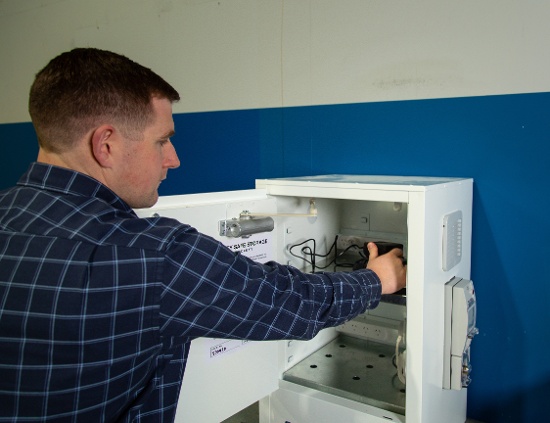From faulty e-scooters catching on fire to discarded lithium ion batteries destroying garbage trucks, you don’t have to search for too long to find stories about lithium battery fires. And with over a billion lithium ion batteries being manufactured every year across the globe, there’s never been a more important time to consider how you can control fire risk with this type of cell. In this blog, we’ll explain some of the hazards associated with lithium ion batteries and offer 3 tips to help control fire risk in your workplace.
Lithium ion Batteries
This increasingly popular type of battery powers a wide range of high-tech equipment such as electric vehicles, cell phones and industrial robots. As a fully rechargeable battery, li ion offers a range of benefits for users including:
- Long lifespan
- Affordability
- Fast charging
- Higher power density
- Low maintenance
- Lightweight battery type
What Hazards Can Occur with Lithium ion Batteries?
While there are ample benefits to using li ion batteries in your workplace, the risk of fire does pose some serious safety issues to consider.
These batteries are manufactured to be recharged, potentially hundreds of times in a lifespan, and their unique chemistry requires careful handling and storage practices.
The battery utilises a form of lithium polymer to provide the fully rechargeable capability of the cell. During use, the lithium ions shift from negative to positive, while the li ion battery discharges. When the battery is on charge, these lithium ions shift in the opposite direction.
However, the key fire hazard associated with lithium-ion batteries lies in the highly flammable electrolyte. If the battery is faulty, not charged correctly or has been exposed to damage, the complex chemistry within the battery can create a fire hazard.
Lithium ion Battery Fires
The greatest hazard with lithium ion batteries is the flammable electrolyte stored within the battery cell. Lithium-ion battery fires generally occur when a battery is on charge, or when flammable electrolyte leaks out and comes in contact with an ignition source.
Lithium ion battery fires pose unique challenges to the fire crew who attend to them, as they are extremely hot, fast-burning fires that are difficult to put out. Add to this the release of dangerous gases from the burning battery, and you have a devastating blaze that can quickly spread throughout an organisation and out into the community.
Preventative measures, as well as the correct firefighting equipment, is required to control the risks associated with li ion battery fires in the workplace.
Thermal runaway also creates a further danger, with batteries able to re-ignite once they have been extinguished. The thermal runaway can affect all surrounding battery cells, increasing the fire (and explosion) risk for workplaces who carry multiple lithium ion batteries.
Lithium ion Battery Fire Triggers
Lithium batteries catch fire for a range of reasons. Some key triggers for fire and explosion risk include:
- Impact damage – causing the battery damage and setting off thermal runaway in the cell/s
- Water damage - any battery exposed to water or salt water must be treated in the same way as a damaged battery as they are dangerous
- Heat and humidity – lithium ion batteries should be kept in cool, dry environments
- Short circuits & manufacturing faults – the battery can become a hazard if damage, manufacturing faults or poor storage practices lead to short circuits in the cell
REMEMBER: Lithium-ion batteries contain a flammable electrolyte, so they must never be placed in general refuse. Contact your local rubbish disposal authorities to find out more about the safe disposal solutions available for your business.
3 Steps to Control Battery Fire Risk
Now that we have an understanding of the basic dangers associated with lithium ion batteries, here’s 3 simple steps that you can take to lower the likelihood and impact of a lithium ion battery fire in your workplace. Remember, it's often the simple, easy steps that you and your team can take that will make the biggest impact when it comes to the risk management of li-ion batteries in your operations.
MPORTANT: In Australia, we don’t yet have a dedicated Safety Standard that applies to lithium ion batteries. Even though this Australian Standard is in development, it’s important to take every precaution to reduce the risk of lithium battery fires.
STEP 1. Store Batteries Correctly
Following the manufacturer’s recommendations for battery storage, make sure you keep your lithium ion batteries in the appropriate environment.
Li-ion batteries need to be kept in a dry, cool and iwell-ventilated storage area.
Storage conditions must be:
- Temperature controlled: storage should be cool, dry and not in direct sunlight. As lithium ion batteries can overheat, the temperature of your store must be monitored and controlled at all times.
- Secure: Keep cells safe and free from impact damage, theft or vandalism.
- Well-ventilated: li ion batteries require a well-ventilated environment, so they don’t overheat. This also prevents thermal runaway.
- Spill protection: spill protection is required for any leaking flammable electrolyte.
- Constructed with a non-combustible material: if there is a risk of fire or explosion with any item (or chemical) at your site, you must ensure that you control the risk by storing it in a non-combustible storage unit. Never store or charge batteries in a wood or plywood cabinet, as this material will only add fuel to the blaze.
IMPORTANT: Our electrically certified battery charging and storage cabinet offers security and protection for your lithium ion batteries. Shelving is fully adjustable to suit all types of batteries and charging equipment. A built-in fan delivers ample cool air to the cabinet, thereby creating a stable environment for charging and storage.
Battery Collection and Transport
In addition to the storage of your batteries, must also consider how you're transporting your batteries. Purpose-built battery safes and transport solutions can provide an optium environment that reduces the likelihood of fire. These safes come in a range of sizes and are also equipped with fire protection to extinguish a fire if it breaks out on the road.
Battery storage and transport can help mitigate lithium-ion battery fire risks in the workplace.
STEP 2. Be Prepared for a Fire
While you can do everything you can to prevent a fire breaking out in your business, it’s also important to equip your team to deal with an incident if it occurs.
Although lithium ion battery blazes can quickly get out of hand, releasing toxic fumes and burning rapidly, you may be able suppress a battery fire in its initial stages. While there is always the risk of re-ignition when it comes to Li-ion batteries, a Dangerous Goods Fire Suppression System cansuppress the fire, giving you enough time to evacuate and call the fire services.
Battery fires can occur in any home, workplace or vehicle charging area.
Combined with batteries being stored in a Battery Charging Cabinet, these layers of protection can help save people, property and the local community from the serious risks posed by battery fires.
It's important to include li-ion batteries in your emergency plan and staff training routine. Speak with your local fire authority for assistance with your emergency plan, as well as guidance on the appropriate fire control measures for all areas of your organisation.
REMEMBER: You should never use water to extinguish a fire that involves energised electrical equipment as it could result in electrocution. When implementing a fire suppression system, ensure that you account for the excess water that may be required when extinguishing a lithium ion battery blaze.
STEP 3. Create Standard Operating Procedures
Just like you would follow the Safety Data Sheet for recommendations on how to handle and store your hazardous chemicals, you should strictly follow the battery manufacturer’s guidelines for recharging.
We suggest creating standard operating procedures that your staff and contractors can be trained to follow. By implementing set procedures for battery handling, charging, storage and disposal, you’ll be able to improve lithium ion battery safety.
Keep in mind that these standard operating procedures should include the:
- Careful handling of the batteries
- Use of correct battery storage
- Regular battery inspections for damage or leaks
- Use of the appropriate charger for each battery
- The prevention of overcharging or overdischarging
- Procedure for disposal of old, unwanted batteries
- Procedures for dealing with flammable electrolyte leaks
- Emergency procedures for fires and other hazards
- Instructions and training for staff
REMEMBER: Charging a faulty battery, overcharging or charging a cell too quickly can also create safety issues that could result in fire involving the flammable electrolyte. Explosions can also occur if the batteries rapidly release their stored energy, creating gas to be expelled from the electrolyte – which can cause a fire or explosion.
Want to Control Thermal Runaway and Lithium Battery Fire Risk?
If you’re interested in reducing the likelihood and risk associated with li ion batteries, we have a free eBook that can help. Our guide will outline the lithium battery fire hazards, as well as tips for battery charging and storage.
Should you require further information about lithium-ion battery management solutions, get in touch with our team who can suggest a suitable solution.

Living life by the 4 C’s of marketing – communication, coffee, compliance… and more coffee – Leisa Andersen is Storemasta’s Content Marketing Manager. When she’s not writing, you’ll find her enjoying all the good things in life, including shopping, travel and gluten free donuts.





